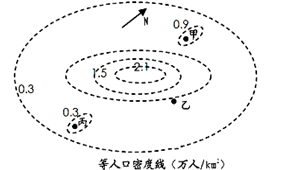问题
选择题
读我国某平原地区人口密度分布图,完成下列问题。

小题1:判断下列说法正确的是
A.该地建筑物高度有中心区向外围递增
B.甲处可能为现代化农业区
C.东北—西南一线人口密度较大
D.丙处可能为卫星城小题2:从热力环流的角度,判断乙处近地面最有可能的风向
A.西南风
B.西北风
C.东北风
D.东南风
答案
小题1:C
小题2:D
题目分析:
小题1:根据等值线弯曲部位——“凸高为低,凸低为高”和等值线局部闭合——“大于大的,小于小的”等规律可以知道:人口密度向外围减少,说明建筑物高度也是向外围递减的; 甲处人口在等密度线处出现峰值说明这地方人口比周围密集,有可能出现卫星城;而丙处正好与甲处相反,人口密度突然出现减少,有可能是农业区,根据图中的指向标,在该地东北—西南方向上等值线向低处凸,说明这个方向上人口密度较大。
小题2:从题目及图中信息可以判断,该地为一个平原城市,根据题干提示“从热力环流角度”,只能从城市热岛效应这个方面去考虑乙处的风向,由城市热岛效应而产生的城市风在城市中心辐合上升,近地面又由郊区流向城市,形成一个城市热力环流,如图:所以选D。

